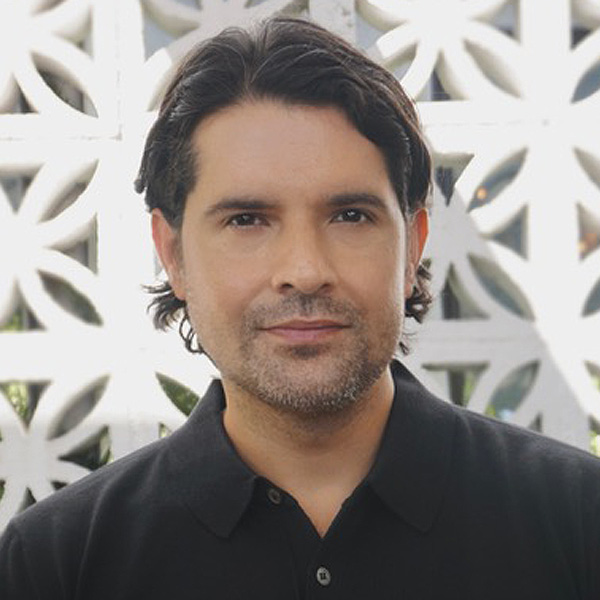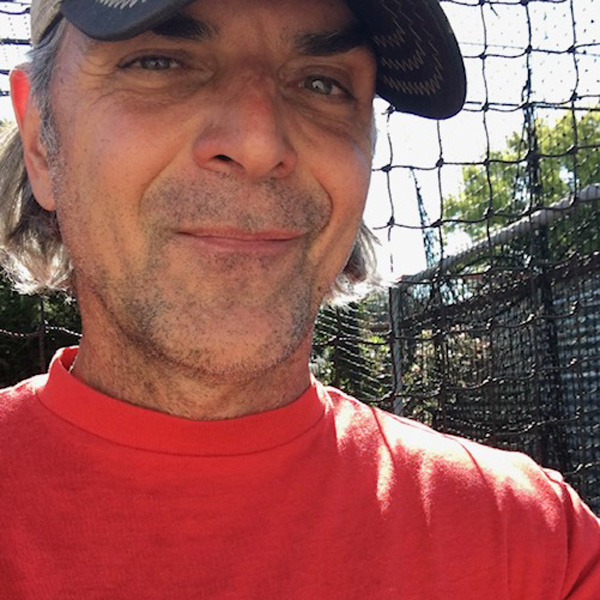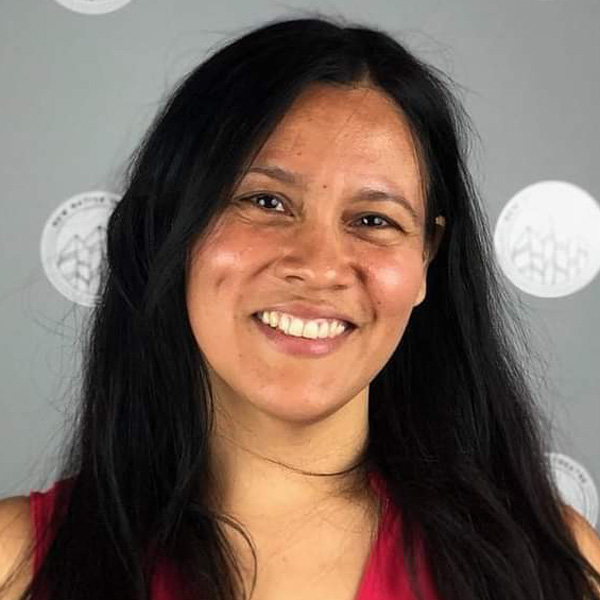Dark Winds first landed on Graham Roland’s desk in 2019, as a possible adaptation of the late Tony Hillerman’s Navajo mystery, Listening Woman. At first Roland, who is Chickasaw, saw it as just one in a number of possible projects. Then he realized that with its tribal police detective, Joe Leaphorn, investigating crime on the reservation, he could fashion something he’d never seen on television: a story starring a Native American, unfiltered by the usual white protagonist introduced as a sop to white audiences. “We were immersed in it by virtue of the Native leads, and that was really fascinating to me,’’ Roland says.
 Dark Winds Creator Graham Roland. Photo by Shelley Rickman
Dark Winds Creator Graham Roland. Photo by Shelley RickmanFor more than 30 years, Robert Redford had owned the rights to Hillerman’s mysteries. In 1991, Neal Jimenez and Eric Bergren penned the adaptation The Dark Wind; then in 2002 Leaphorn showed up again in PBS’s Skinwalkers: The Navajo Mysteries (Teleplay by the late James Redford, Robert’s son). Now Redford was aiming for cable television.
From the beginning, Roland, Redford, and other executive producers, including George R.R. Martin, director Chris Eyre, and star Zahn McClarnon (Leaphorn), were firm about staffing the show with Native writers.
“We wanted to make sure that this story was getting re-contextualized, and filtered, and adapted for television, through a Native lens. That was more important than any level of experience someone could bring to the table,” explains Roland, about setting up season 1.
According to the 2022 Writers Guild of America West Inclusion and Equity Report, Native American, Indigenous, and First Nations writers accounted for fewer than one percent of those working in 2020 in television and film. Still, Roland was agreeably surprised by the size of the talent pool: “It was much deeper than I was anticipating, because not a lot of Native writers had been given their chance,” he says.
The result: Dark Winds, which debuted in 2022 and was quickly renewed for a second and then a third season, became the first drama with a room completely staffed, with the exception of showrunner Vince Calandra, by writers of Native American heritage.
Humanity First
 Jason Gavin
Jason GavinAdapting a popular book for the screen is tricky when a novelist’s fans—and Hillerman had millions—are ready to pounce on changes. Roland, a veteran of Prison Break (Created by Paul T, Scheuring), and Lost (Created by Jeffery Lieber and J.J. Abrams & Damon Lindelof), had co-created Amazon’s Tom Clancy’s Jack Ryan with Carlton Cuse, so adaptation wasn’t new for him.
“Many of the things that Tony had done in his novels made for good TV,” Roland says. “At the same time, I was looking for a deepening of some of the character work, and what the characters were going through, that I felt would make it a little bit more accessible for a television audience.”
In Hillerman’s early books, Leaphorn works alone. But Redford and Martin envisioned the show as a two-hander with a younger lieutenant, Jim Chee. Chee doesn’t appear until Hillerman’s fourth mystery in the series, People of Darkness, which would become the basis for Dark Winds’ second season. Roland returned Chee to the reservation early—an outsider after a decade away—to work with Leaphorn, whose parents had sent him to assimilation school to be stripped of his Navajo language and customs. Only after filming finished, did someone point out to Roland the link between his protagonists’ histories and his own disconnected childhood: after age 8, he split his time between his mother in California’s Bay Area, and his father in Ardmore, Oklahoma, never quite fitting in either place.

We wanted to make sure that this story was getting re-contextualized, and filtered, and adapted for television, through a Native lens. That was more important than any level of experience someone could bring to the table.
- Graham Roland
He also imported Leaphorn’s wife, Emma, from later books, gave the childless Leaphorns a son, and, with the other executive producers, remained determined to shun Magical Indians, flute music, and peace pipe smoking.
“It ended up being such an important part of how we were looking at the episodes, trying to make them feel like they were not falling into stereotypical spaces,” he says. “Making it feel like a grounded crime drama first, and then a story that took place on the reservation, second.”
Keeping the series in the ’70s, like the novel, allowed Roland to release his cops from cell phones and technology, but also to touch on dramatically-charged Native issues still relevant today, yet closer to the surface then: police sergeant Bernadette Manuelito had run away from boarding school; white uranium mining interests were polluting Native land; racism was open; Native women were being involuntarily sterilized by government decree. Giving Emma Leaphorn a career as a midwife allowed both seasons to explore that last barbarism.
“You can’t shake that history,” says Roland. “But it was important not to be heavy-handed about it.”
Heart and Head
 Vince Calandra
Vince CalandraOriginally, Dark Winds was slated for HBO. When they dropped out, AMC picked it up. But Roland hit a snag: an overall deal with Skydance Media precluded his day-to-day presence in the writers’ room, but did allow him to consult.
He received notes from Redford, Martin, AMC, and other executive producers. Showrunner Vince Calandra received notes only from the network and Roland, who ducked into the Zoom room whenever he could.
“I was literally on the edge of my seat some days just listening to them tell their stories,” Calandra says about the season 1 writers. “I forgot this was a writers’ room. I felt like I’m just sitting at a coffee shop listening to someone tell someone else a story that is just riveting. All of that was put into the [show].”
Staffing the room for season 2, new showrunner John Wirth hired five Native writers: Dezbaà, Jason Gavin, Steven Judd, Billy Luther, and Rhiana Yazzie. He was as impressed as Roland: “I probably could have staffed five or six writers’ rooms based on the number of writers that I met and read, and whose talent I thought was really on a par with anybody.” (Non-Native Max Hurwitz joined as co-executive producer.)
 John Wirth
John Wirth“I can tell a compelling mystery,” says Wirth. “I know when the emotional beats should hit. I can look at the scene and say, ‘What does that character want? What's preventing that character from getting it? What happens if that character doesn’t get it?’ But I can’t live in the shoes of Native people in this country, and I’m not in their hearts or in their heads. I’m really proud of what we did in terms of telling this story in an authentic way.”
Says Yazzie, a much-awarded Navajo playwright who made her television debut with Dark Winds, “I felt like it was a room where everybody’s gifts and talents were really held up to the light, and that if you had something to offer, it was 100 percent welcomed.”
Benign Connection
A showrunner since the ’90s, and co-editor with Jeff Melvoin of the handbook that paved the way for the WGA Showrunner Training Program, Wirth says his style has evolved.
“I’m the kinder gentler me,” he says. “I don’t chop people’s heads off anymore.”
Co-executive producer Gavin (Blackfeet), who was the first to chair the WGAW’s Native American and Indigenous Writers Committee, welcomed Wirth’s approach. They largely broke a story in the room, the designated writer created an outline, submitted it to Wirth, collaborated with him on it, wrote the script alone, then Wirth edited.
“As the writer you feel very connected,” says Gavin. “I’ve worked on other shows where, either because of process, or you’re in a time crunch, you end up a bunch of people kind of Frankenstein-ing a script together. That can work, and certainly gets it done more quickly, but you don’t necessarily feel as emotionally connected.”
 Rhiana Yazzie
Rhiana YazzieWhen it came to the season finale, Roland recalls feeling “over the moon” when Wirth asked if he’d like to co-write it.
“We would just write and trade pages, and we had no ego about it. It was all about just making it the best it could be,” Roland says. “John and I essentially adopted the same thing, which is I would write my pages, he would write his pages, then we’d swap, and we would keep trading back and forth until we felt like we had it.”
Wirth remembers the episode being too long, “In the case of Graham and I loving everything we wrote,” he says. “I just kept nibbling at it, and gently pulling it down in size until we got to the final shooting script. But I’m very happy with that episode. It wrapped a lot of stuff up. It was very emotional, and just the kind of almost maudlin stuff I enjoy writing.”
Looking back, says Roland: “It was one of my favorite co-writing experiences I’ve ever had in my career. I felt like everything that I put on the page, John elevated slightly, and then it goes to Zahn and all of our wonderful actors, and then they elevate it.”







